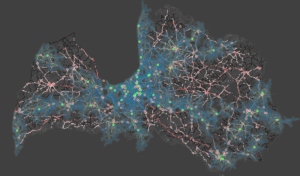The goal of this project is to improve the safety and reliability of the TEN-T network in general with the implementation of the harmonized traffic counting points system in the whole comprehensive and core network of the TEN-T in Latvia which will allow more effective and safe management of traffic.
This project will help to achieve the modernization of the transport infrastructure for the core and comprehensive networks of the TEN-T. In Latvia, modern technological solutions will be implemented for existing and new traffic counting points, based on the result of the study. Counting points will also be installed on illuminated pedestrian/bicycle paths near the TEN-T network to determine pedestrian presence during night-time and control the illumination accordingly. To collect, analyze and manage all traffic data that will be available from the new ITS infrastructure, a modernized traffic management program will be implemented. In the TEN-T network in Latvia there will therefore be ITS solutions and possibilities to manage traffic equal to other EU countries.
To ensure the digitalization of transport sectors and increase the availability of data for transport safety in the whole TEN-T road network, it is important to involve smart and innovative solutions for the creation, collection, management, sharing, and dissemination of transport data. In Latvia, this is still an unsolved but essential issue. Especially related to the implementation of transport National Access Point (NAP). Therefore, on the core and comprehensive networks of the TEN-T in the territory of Latvia this project is planned to introduce digital solutions for the creation and management of traffic data.
Realization of this project will supplement project No.6.1.6.0/21/I/001 implemented by LSR (2021-2023) and co-financed by the Cohesion Fund “Implementation of the national access point for transport sector information in Latvia” (NAP project) and promote compliance with the requirements of the ITS Directive and Regulations No. 885/2013, No. 886/2013, No. 2015/96, No. 2017/1926. Due to the implementation of this project, the missing part of the NAP project, which is urgently important for the functioning of the NAP, will be implemented – the creation and management of the traffic data.


The main objective of this project is to improve the safety and reliability of the TEN-T network in Latvia.
Four main activities will be implemented till the end of the MERIDIAN project in December 2025:
The main task of the study is to evaluate the efficiency of the existing traffic counting point layout in the TEN-T network in Latvia and to provide recommendations for the improvement and expansion of the traffic counting network, locations, and remote sensor type of traffic counting points. This study will be used to modernize at least 37 existing permanent traffic counting points by replacing induction loop sensors with radar or laser-type sensors. The main benefit is moving all traffic counting equipment out of the carriageway, so there is no need to renew the sensors when repaving the section or in the case when the magnetic loops are damaged due to pavement deformations, thus reducing maintenance costs.
It is planned to modernize existing permanent traffic counting points with non-invasive sensors. And improve the TEN-T network coverage in Latvia with approximately 20 new permanent traffic counting points by installing the same equipment as in previously modernized traffic counting points. This is necessary because they will ensure the acquisition and data transfer in DATEX II format so that it will be possible to integrate this information with NAP services. The following data will be obtained: traffic intensity (number), movement speed, classification, and direction.
Vulnerable road users are not currently counted. The obtained data will be used to control the lighting intensity. By analyzing the trends and intensity of movement, it will be possible to determine the time frame when the lighting level could be reduced to a minimum or switched off, thus achieving energy savings, and maintaining safety.
Improved traffic data analysis provides analysis of traffic processes, which is essential for understanding road network performance. A wide range of analytics can help users monitor travel time, build traffic patterns, and monitor congestion. Traffic engineers can prepare reports and act where needed.
This project will improve the safety and reliability of the TEN-T network in general with the implementation of the harmonized traffic counting points system in the whole comprehensive and core network of the TEN-T in Latvia which will allow more effective and safe management of traffic.